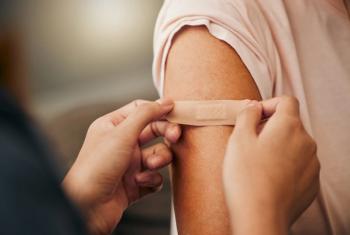
- Consultant for Pediatricians Vol 4 No 10
- Volume 4
- Issue 10
Pediatrics Update: Avian Flu: Why All the Squawk?
Pediatricians around the countryare being bombardedwith questions about avianflu. This brief review of thecurrent status of the avian fluoutbreak and its treatment and preventionprovides the informationyou will need to answer the mostpressing patient questions.
Pediatricians around the countryare being bombardedwith questions about avianflu. This brief review of thecurrent status of the avian fluoutbreak and its treatment and preventionprovides the informationyou will need to answer the mostpressing patient questions.
WHAT IS AVIAN FLU--AND WHAT'S ALL THE FUSS?
Avian flu, or "bird flu," is a predominantlyrespiratory illness causedby influenza viruses normally foundin birds. These viruses are geneticallydistinct from influenza viruses thatinfect humans. The avian influenzaA viral strain of H5N1 is the focusof media attention for a number ofreasons:
- H5N1--1 of 15 avian virus subtypes--mutates rapidly.
- It has the propensity to acquiregenes from influenza viruses thataffect other species.
- It can cause severe disease inhumans.
- Infected birds can spread it throughsaliva and feces.
The first cases of known humaninfection occurred in 1997 in HongKong.1 Since then, more reportshave surfaced. Between January2004 and April 2005, avian flu killedmore than 50 people in Vietnam,Cambodia, and Thailand.2
Wild, migratory birds are a naturalreservoir for H5N1. Infection ofdomestic poultry in Southeast Asia,western China, Turkey (most recently),and possibly, Romania, hasheightened the attention given to thisinfection. The avian H5N1 virus isspread easily from bird to bird; reportsof the spread of this virus frombirds to humans are increasing.Human-to-human spread--which isvery rare--probably occurred in acluster of cases in a family from Thailand.3 So far, however, human-tohumantransmission has not been observedbeyond a single person andtherefore is not sustained. As thenumber of cases of human infectionincreases, however, the opportunitiesfor the virus to evolve into a strainthat is more easily transmissiblefrom human to human will increase.
The influenza virus genomecan change frequently; it has a high mutation rate and can segment into8 separate RNA molecules.2 Thissegmentation allows genetic exchange(reassortment) in hosts whoare coinfected with 2 different influenzaviruses. Reassortment couldresult in a human-avian hybrid thathas the ability to spread easily fromperson to person.
To date, there is no evidencethat the 2004-2005 H5N1 isolateshave acquired nonavian influenzagenes by reassortment. However,the recent isolate circulating in Vietnamappears to be much more virulentthan the 1997 isolate.4
Human influenza pandemicshave occurred at irregular intervals(in 1918, 1957, and 1968), and it isunknown when the next one willoccur. There is worry that the worldis overdue for another influenza pandemicand that the potentially lifethreateningavian flu virus, to whichhumans have no past immunity, maybecome more easily transmissiblefrom person to person. This will beparticularly true as the number ofcases of bird-to-human transmissionincreases and another human influenzapandemic may be justaround the corner.
WHO GETS THEAVIAN FLU--AND HOW DOYOU GET IT?
At the time of this publication,no human cases of avian flu have occurredin the United States. However,persons of all ages can becomeinfected. Age greater than 13 yearsmay be a risk factor for more severedisease.1
Infected birds shed virus insaliva, nasal secretions, and feces.Exposure to these birds in an areawith high infection rates is the greatestrisk factor for contracting avianflu. Humans may become infectedthrough contact with the diseasedbird in a live market or duringpreparation for its consumption. Defeathering causes aerosolization ofvirus particles, which may land onexposed mucosal surfaces of themouth, eyes, and nose and subsequentlybe inhaled into the lungs.Bridges and colleagues5 found thatthe butchering of infected birds isassociated with the development ofanti-H5 antibodies.
Although ingestion of contaminatedpoultry is an unlikely mode oftransmission (it was not associatedwith infection in the earliest cases),fecal-oral spread by direct contact ofa person's mucous membranes withthe contaminated poultry is possible.6 Isolation of H5N1 from fecalspecimens of a 4-year-old Vietnameseboy who presented with severediarrhea and no respiratory symptomswas reported.6
As noted, human-to-humanspread is rare but is more likelywhen one has been in close contactwith the index case.3 Contaminatedenvironmental surfaces may alsopose a substantial risk.6
WHAT IS THECLINICAL PRESENTATIONOF AVIAN FLU?
An "influenza-like" illness withfever, malaise, myalgias, and respiratorytract symptoms is the likelypresentation. GI symptoms are nottypical, but diarrhea as well as comahave occurred secondary to avianflu, as described in the 4-year-oldVietnamese boy.6
A progressive primary viralpneumonia may be accompanied bylymphopenia, elevated serum liverenzyme levels, and reactive hemophagocytosis.Children youngerthan 5 years may display mildersymptoms, but infants in the firstseveral months of life are at greaterrisk for complications when infectedwith human influenza viruses. Alongwith age greater than 13 years, factorsassociated with severe diseaseinclude a delay in hospitalization, lower respiratory tract involvement,low total peripheral white bloodcount, and lymphopenia.1
HOW IS AVIAN FLUDIAGNOSED?
The patient's history and clinicalscenario should alert you to thepossibility of avian flu. Testing foravian H5N1 should be considered ona case-by-case basis in consultationwith state and local health departments,as advised by the CDC.7 TheCDC recommends testing in personswho have all of the following:
- A documented fever (temperaturehigher than 38C [100.4F]).
- One or more of the following symptoms:cough, sore throat, shortnessof breath.
- A history of contact with poultryor with persons who are knownto have or suspected of having avianflu in an affected area within 10 daysof symptom onset.
Viral culture, polymerasechain reaction, and antigen testingapplied directly to specimens arepossible methods of diagnosis.Laboratories must meet the specifiedsafety requirements to processspecimens suspected of harboringthe H5N1 virus. A local infectiousdisease expert, the local healthdepartment, and the CDC can offerguidance about proper diagnostictesting.
HOW IS AVIAN FLUTREATED?
Supportive measures--oxygen,adequate hydration, and close monitoring--are the mainstay of treatmentfor patients with all types offlu. Neuraminidase inhibitors (oseltamivirand zanamivir) are effectiveantiviral drugs against human influenzaviruses. All the recent isolatesof avian H5N1 from humanshave been sensitive to the neuraminidaseinhibitors but have beenresistant to amantadine and rimanta dine.2 Because of the risk of Reyesyndrome, aspirin should not begiven to a child in whom any type ofinfluenza is suspected.
MOST IMPORTANT,HOW IS IT PREVENTED?
As always, good hand washingand avoidance of close contact withsick persons is important in controllingthe spread of infection. Educatingchildren and parents about respiratoryhygiene and cough etiquetteis crucial in helping preventthe spread of infection. During periodsof increased respiratory infectionsin the community, patientswho are coughing should be providedwith masks.
At this time, there are no recommendationsto avoid eating poultry.However, poultry throughout theworld are under close surveillance.
When a patient is admitted becauseH5N1 infection is suspected orhas been diagnosed, he or sheshould be hospitalized in a negative-air-pressure room. In addition tostandard hand hygiene, health careworkers should wear gloves and agown during all patient contact. Eyeprotection and a fit-tested respiratorare recommended for those whocome within 3 feet of the patient.
The standard flu vaccine is recommendedfor all eligible persons tocontrol the spread of human influenza.8 This is especially true for thosewho have come in contact with patientsin whom avian flu is confirmedor suspected.
In May 2004, the National Instituteof Allergy and Infectious Diseasesannounced contracts for thedevelopment of a vaccine againstavian H5N1. Trials are currentlyunder way: reports in August 2005indicated that a vaccine had beenshown to produce a robust immuneresponse.9
We encourage readers to keepabreast of this situation. The CDC, the NIH, and the World HealthOrganization offer up-to-date informationabout the vaccine and aboutthe status of avian and human influenzaoutbreaks.2
References:
REFERENCES:
1.
Yuen KY, Chan PK, Peiris M, et al. Clinical featuresand rapid viral diagnosis of human disease associatedwith avian influenza A H5N1 virus. Lancet.1998;351:467-471.
2.
The World Health Organization Global InfluenzaProgram Surveillance Network. Evolution of H5N1avian influenza viruses in Asia. Emerg Infect Dis [serialonline]. Available at:
www.cdc.gov/ncidod/EID/vol11no10/05-0644.htm
. Accessed October 18, 2005.
3.
Ungchusak K, Auewarakul P, Dowell SF, et al.Probable person-to-person transmission of avian influenzaA (H5N1). N Engl J Med. 2005;352:333-340.
4.
Li KS, Guan Y, Wang J, et al. Genesis of a highlypathogenic and potentially pandemic H5N1 influenzavirus in eastern Asia. Nature. 2004;430:209-213.
5.
Bridges CB, Lim W, Hu-Primmer J, et al. Risk ofinfluenza A (H5N1) infection among poultry workers,Hong Kong, 1997-1998. J Infect Dis. 2002;185:1005-1010.
6.
Ahmad K. Vietnamese cases suggest avian flu hasbeen underestimated. Lancet Infect Dis. 2005;5:200.
7.
Centers for Disease Control and Prevention. Updateon Avian Influenza A (H5N1). February 4, 2005.Available at:
http://www.cdc.gov/flu/avian/professional/han020405.htm
. Accessed October 18,2005.
8.
Nield LS, Kamat D. "Flu" season: are you ready?Consultant for Pediatricians. 2004;3:436-440.
9.
Bonn D. Infectious disease surveillance update.Lancet Infect Dis. 2005;5:540.
Articles in this issue
about 20 years ago
Carbon Monoxide Poisoning: Clues to Unmasking the Great Masqueraderabout 20 years ago
Pediatrics Update: Amblyopia Therapy Is for Older Children Tooabout 20 years ago
Tinea Faciei and Tinea Versicolorabout 20 years ago
Photoclinic: Hooked Fingerabout 20 years ago
What’s Wrong With This Picture? Child With Fever and Persistent Coughabout 20 years ago
Photoclinic: Plexiform Neurofibromaabout 20 years ago
Photoclinic: Perianal Streptococcal Dermatitisabout 20 years ago
Photoclinic: Bohn Nodulesabout 20 years ago
Photoclinic: Congenital Melanocytic NevusNewsletter
Access practical, evidence-based guidance to support better care for our youngest patients. Join our email list for the latest clinical updates.









